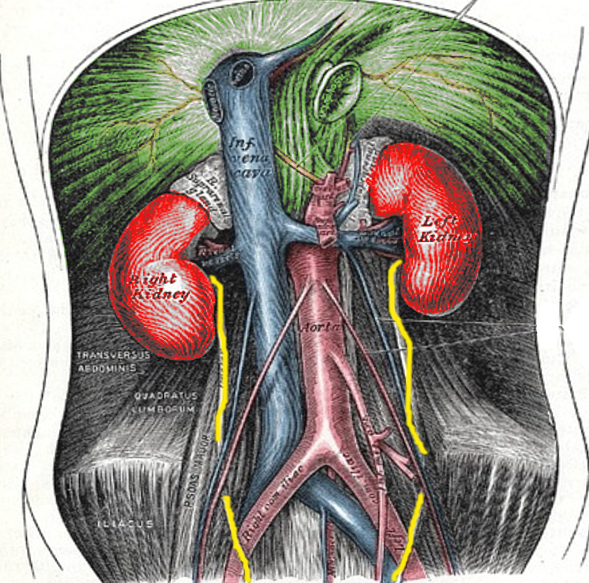[1]
Tirkes T, Sandrasegaran K, Patel AA, Hollar MA, Tejada JG, Tann M, Akisik FM, Lappas JC. Peritoneal and retroperitoneal anatomy and its relevance for cross-sectional imaging. Radiographics : a review publication of the Radiological Society of North America, Inc. 2012 Mar-Apr:32(2):437-51. doi: 10.1148/rg.322115032. Epub
[PubMed PMID: 22411941]
Level 2 (mid-level) evidence
[2]
Vesselle HJ, Miraldi FD. FDG PET of the retroperitoneum: normal anatomy, variants, pathologic conditions, and strategies to avoid diagnostic pitfalls. Radiographics : a review publication of the Radiological Society of North America, Inc. 1998 Jul-Aug:18(4):805-23; discussion 823-4
[PubMed PMID: 9672967]
[3]
Rajiah P, Sinha R, Cuevas C, Dubinsky TJ, Bush WH Jr, Kolokythas O. Imaging of uncommon retroperitoneal masses. Radiographics : a review publication of the Radiological Society of North America, Inc. 2011 Jul-Aug:31(4):949-76. doi: 10.1148/rg.314095132. Epub
[PubMed PMID: 21768233]
[4]
Selçuk İ, Ersak B, Tatar İ, Güngör T, Huri E. Basic clinical retroperitoneal anatomy for pelvic surgeons. Turkish journal of obstetrics and gynecology. 2018 Dec:15(4):259-269. doi: 10.4274/tjod.88614. Epub 2019 Jan 9
[PubMed PMID: 30693143]
[5]
Stallard DJ, Tu RK, Gould MJ, Pozniak MA, Pettersen JC. Minor vascular anatomy of the abdomen and pelvis: a CT atlas. Radiographics : a review publication of the Radiological Society of North America, Inc. 1994 May:14(3):493-513
[PubMed PMID: 8066265]
[6]
Mirilas P, Skandalakis JE. Surgical anatomy of the retroperitoneal spaces, Part III: Retroperitoneal blood vessels and lymphatics. The American surgeon. 2010 Feb:76(2):139-44
[PubMed PMID: 20336888]
[7]
Mirilas P, Skandalakis JE. Surgical anatomy of the retroperitoneal spaces, Part IV: retroperitoneal nerves. The American surgeon. 2010 Mar:76(3):253-62
[PubMed PMID: 20349652]
[8]
Strauss DC, Hayes AJ, Thomas JM. Retroperitoneal tumours: review of management. Annals of the Royal College of Surgeons of England. 2011 May:93(4):275-80. doi: 10.1308/003588411X571944. Epub
[PubMed PMID: 21944791]
[9]
Mirilas P, Skandalakis JE. Surgical anatomy of the retroperitoneal spaces, Part V: Surgical applications and complications. The American surgeon. 2010 Apr:76(4):358-64
[PubMed PMID: 20420243]
[10]
Song YJ, Suh DS, Kim KH, Na YJ, Lim MC, Park SY. Suprarenal lymph node dissection by the Kocher maneuver in the surgical management of ovarian cancer. International journal of gynecological cancer : official journal of the International Gynecological Cancer Society. 2019 Mar:29(3):647-648. doi: 10.1136/ijgc-2018-000093. Epub 2019 Feb 7
[PubMed PMID: 30733277]
Level 2 (mid-level) evidence
[11]
Kitahara M, Ohata T, Yamada Y, Yamana F, Nakahira S. The Cattell-Braasch maneuver might be a good option for a huge abdominal aortic aneurysm. Journal of vascular surgery cases and innovative techniques. 2019 Mar:5(1):35-37. doi: 10.1016/j.jvscit.2018.07.008. Epub 2019 Jan 12
[PubMed PMID: 30671564]
Level 3 (low-level) evidence
[12]
Del Chiaro M, Segersvärd R, Rangelova E, Coppola A, Scandavini CM, Ansorge C, Verbeke C, Blomberg J. Cattell-Braasch Maneuver Combined with Artery-First Approach for Superior Mesenteric-Portal Vein Resection During Pancreatectomy. Journal of gastrointestinal surgery : official journal of the Society for Surgery of the Alimentary Tract. 2015 Dec:19(12):2264-8. doi: 10.1007/s11605-015-2958-1. Epub 2015 Sep 30
[PubMed PMID: 26423804]
[13]
Cronin CG, Lohan DG, Blake MA, Roche C, McCarthy P, Murphy JM. Retroperitoneal fibrosis: a review of clinical features and imaging findings. AJR. American journal of roentgenology. 2008 Aug:191(2):423-31. doi: 10.2214/AJR.07.3629. Epub
[PubMed PMID: 18647912]
[14]
Kasotakis G. Retroperitoneal and rectus sheath hematomas. The Surgical clinics of North America. 2014 Feb:94(1):71-6. doi: 10.1016/j.suc.2013.10.007. Epub 2013 Oct 26
[PubMed PMID: 24267499]


